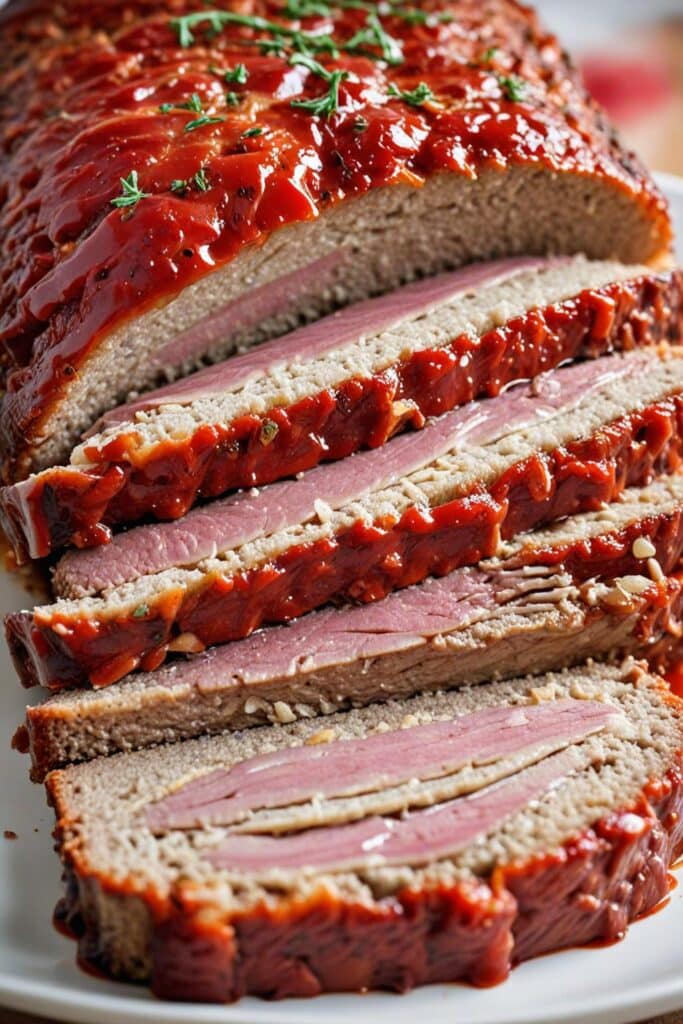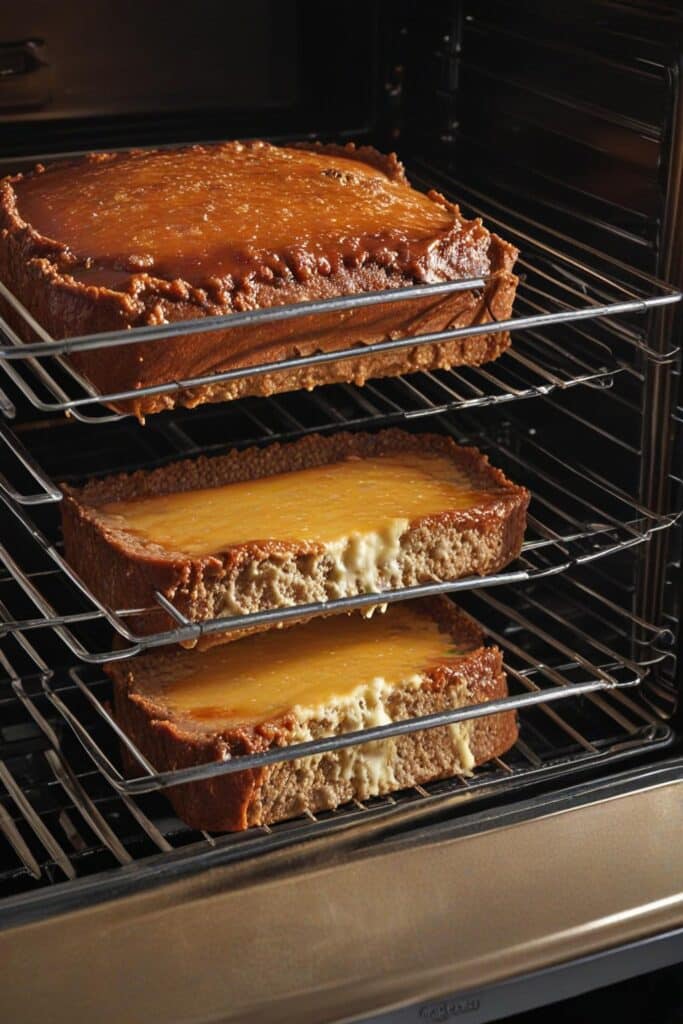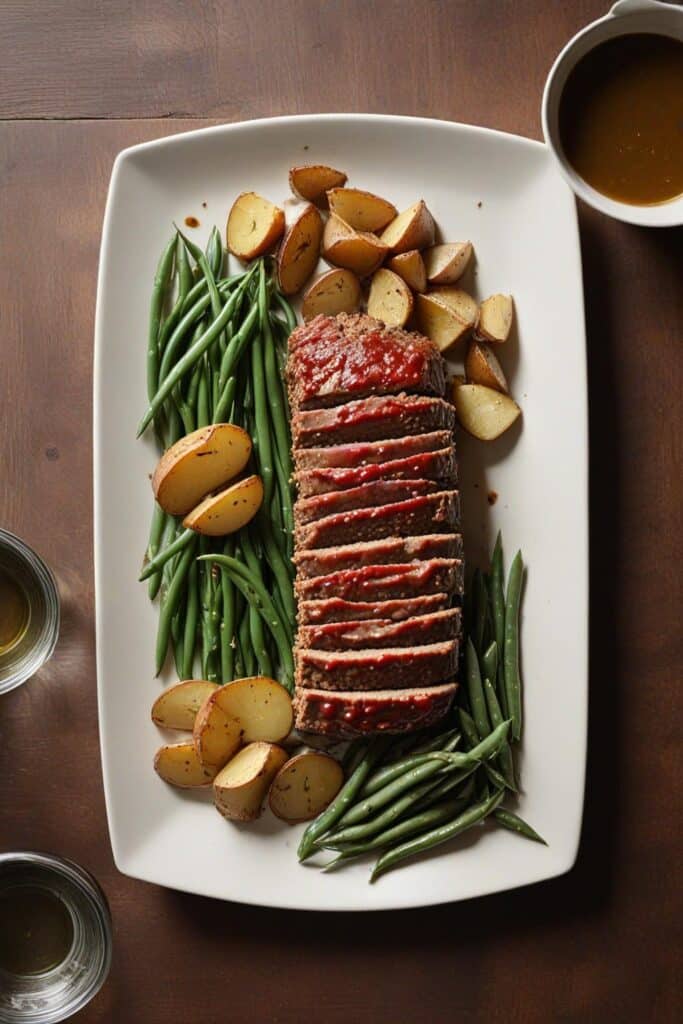I’ll never forget the night I first created this dish. Standing in my kitchen at 11 PM, staring at leftover ground beef and a block of provolone, I had one of those “what if” moments that every chef lives for. What if I could capture the soul of Philadelphia’s most iconic sandwich in the comforting embrace of a traditional meatloaf?
That experimental evening birthed what I now consider one of the most brilliant comfort food fusions I’ve ever developed. This isn’t just meatloaf with cheese thrown in—it’s an architectural marvel that layers the essential elements of a proper Philly cheesesteak into a cohesive, sliceable masterpiece.
The magic lies in understanding that a great cheesesteak is about more than just meat and cheese. It’s about the interplay of textures, the way caramelized onions meld with tender beef, how the right cheese creates those perfect pulls, and most importantly, how every bite delivers that unmistakable Philly experience. We’re taking those principles and reimagining them in meatloaf form.
What Makes This Recipe Special
This isn’t your grandmother’s meatloaf, though it carries the same soul-warming qualities. We’re incorporating the holy trinity of Philly cheesesteak ingredients—beef, cheese, and onions—but we’re doing it with technique and intention. The result is a dish that’s familiar yet surprising, comforting yet sophisticated.
The technique borrows from classic French pâté-making, where we create distinct layers that remain separate during cooking but harmonize on the palate. We’re building flavor complexity through caramelization, umami development, and strategic cheese placement that creates pockets of molten goodness throughout each slice.
Ingredients & Substitutions
For the Meat Base:
- 2 pounds ground beef (80/20 blend works best)
- 1/2 pound ground pork (adds richness and moisture)
- 1 cup fresh breadcrumbs (day-old Italian bread, crusts removed)
- 1/2 cup whole milk
- 2 large eggs
- 2 tablespoons Worcestershire sauce
- 1 tablespoon garlic powder
- 2 teaspoons kosher salt
- 1 teaspoon black pepper
For the Cheesesteak Elements:
- 3 large yellow onions, thinly sliced
- 2 bell peppers (green preferred, but mix colors for visual appeal)
- 8 oz mushrooms, sliced (baby bellas or shiitakes work beautifully)
- 8 oz provolone cheese, sliced thick
- 4 oz cream cheese, softened
- 3 tablespoons butter
- 2 tablespoons olive oil
- 1 teaspoon smoked paprika
For the Glaze:
- 1/4 cup ketchup
- 2 tablespoons brown sugar
- 1 tablespoon apple cider vinegar
- 1 teaspoon hot sauce (Crystal or Frank’s RedHot)
Smart Substitutions
Ground beef quality matters enormously here. If you can’t find an 80/20 blend, mix 85/15 with a bit of ground chuck for that perfect fat ratio. Too lean and your meatloaf becomes dense and dry; too fatty and it’ll fall apart.
Can’t find provolone? American cheese works, though it lacks the sharp bite that makes this dish sing. Aged white cheddar is actually my secret alternative—it melts beautifully and adds a complexity that surprises people. For those avoiding dairy, there are some excellent plant-based provolone alternatives, though you’ll need to adjust cooking times slightly.
The mushrooms aren’t traditional in every Philly cheesesteak, but they add an earthy depth that elevates this dish beyond its sandwich origins. Skip them if you must, but you’re missing out on serious umami development.
Step-by-Step Instructions

Preparing the Vegetables
Start by heating butter and olive oil in your largest skillet over medium heat. This is where patience becomes your best friend. Add those sliced onions and let them work their magic slowly. We’re talking 20-25 minutes of gentle cooking until they’re golden brown and sweet. Don’t rush this step—properly caramelized onions are the foundation of authentic Philly flavor.
Add the sliced peppers and mushrooms to the pan during the last 10 minutes of onion cooking. Season everything with salt, pepper, and that smoked paprika. The vegetables should be tender but still have some texture. Nobody wants mushy veggies in their meatloaf.
Let this mixture cool completely before assembly. Hot vegetables will start cooking your meat mixture prematurely and create a texture nightmare.
Building the Meat Base
In a large bowl, combine breadcrumbs and milk. Let them soak for about 5 minutes until the bread is completely saturated. This panade technique, borrowed from classic French cooking, ensures your meatloaf stays moist and tender.

Add the softened cream cheese to the breadcrumb mixture and mash it in thoroughly. This is where the magic happens—cream cheese adds richness and helps bind everything together while creating those pockets of creamy texture that make each bite interesting.
Gently fold in the ground beef and pork, along with eggs, Worcestershire, garlic powder, salt, and pepper. Here’s where most people go wrong: they overmix. Treat this meat mixture like you’re handling precious cargo. Mix just until combined—overworking develops gluten and creates a tough, dense result.
Assembly Technique
Line a 9×5 loaf pan with parchment paper, leaving some overhang for easy removal. This step saves you from disaster later. Press half of your meat mixture into the bottom of the pan, creating an even layer. Make a shallow well down the center—this is where your cheese and vegetables will nestle.
Layer half of your provolone slices in that well, then add your cooled vegetable mixture. Top with the remaining cheese, then carefully spread the remaining meat mixture over the top. Seal the edges by pressing gently—you want to encase all those beautiful fillings.
The key is creating a proper seal so your cheese doesn’t leak out during cooking. Think of it like making a giant ravioli.
Cooking Process
Preheat your oven to 350°F. Mix your glaze ingredients and brush half over the top of your meatloaf. Reserve the rest for later.
Here’s a crucial tip most recipes miss: place your loaf pan on a rimmed baking sheet. Cheese will inevitably leak a bit, and nobody wants to clean melted cheese off their oven floor.
Bake for 45 minutes, then brush with the remaining glaze. Continue cooking for another 15-20 minutes until the internal temperature reaches 160°F. A meat thermometer is non-negotiable here—guessing leads to either raw centers or overcooked disappointment.
Cooking Techniques & Science
The genius of this recipe lies in understanding how different ingredients behave under heat. The cream cheese melts and creates pockets of richness throughout the loaf. The provolone provides those satisfying cheese pulls we associate with great cheesesteaks, while the caramelized vegetables add sweetness and texture contrast.

The 80/20 beef blend is scientifically optimal for meatloaf. The fat content provides moisture and flavor, while the protein structure holds everything together. Adding pork increases the overall fat content slightly and contributes different amino acids that enhance the overall flavor profile through the Maillard reaction.
Temperature control is critical. Cooking at 350°F allows the proteins to set properly without drying out. Higher temperatures would create a tough exterior before the center cooks through. Lower temperatures wouldn’t develop proper browning on the surface.
The glaze serves multiple purposes beyond flavor. The sugars caramelize during cooking, creating an attractive, glossy surface. The acidity from the vinegar balances the richness of the cheese and meat, while providing a slight tang that brightens the overall dish.
Equipment Considerations
A standard 9×5 loaf pan works perfectly, but don’t use glass. Metal conducts heat more evenly and gives you better browning. If you only have glass, reduce the oven temperature by 25°F and increase cooking time slightly.
An instant-read thermometer isn’t optional—it’s essential. The difference between 155°F and 165°F is the difference between juicy perfection and dry disappointment.
Serving & Pairing Suggestions
Let your meatloaf rest for at least 10 minutes before slicing. This allows the juices to redistribute and the cheese to set slightly, making cleaner slices possible. Use a sharp knife and wipe it clean between cuts for the most attractive presentation.
Slice thick—about 3/4 inch pieces—to showcase those beautiful layers. Arrange on warmed plates with a dollop of the pan juices spooned alongside.
Perfect Pairings
This dish begs for classic American sides with a twist. Garlic mashed potatoes are obvious but brilliant. The creamy texture complements the meat’s richness while providing a neutral backdrop for the bold flavors.

Roasted asparagus with lemon zest adds a bright, slightly bitter contrast that cuts through the richness beautifully. The key is not overcooking—we want some snap to contrast with the meatloaf’s tender texture.
For something unexpected, try a simple arugula salad with a sharp vinaigrette. The peppery greens and acidic dressing cleanse the palate between bites.
Beverage Recommendations
A full-bodied red wine like Cabernet Sauvignon or Malbec stands up beautifully to this dish’s richness. The tannins cut through the fat while complementing the beef’s savory elements.
For beer lovers, reach for something with enough body to match the dish—a porter or brown ale works wonderfully. The roasted malt flavors echo the caramelized onions while providing refreshing carbonation.
Creative Variations
Once you’ve mastered the basic technique, the variations are endless. Try substituting different cheese combinations—aged cheddar and gruyere create a more sophisticated flavor profile. Adding sautéed jalapeños brings heat without overwhelming the other flavors.
For a breakfast variation, incorporate some crumbled bacon into the vegetable mixture and serve with scrambled eggs on top. It’s indulgent but absolutely delicious.
Make-Ahead Tips
This meatloaf actually improves after a day in the refrigerator. The flavors meld and develop, creating an even more cohesive dish. Assemble completely, wrap tightly, and refrigerate up to 24 hours before baking. Add 10-15 minutes to the cooking time if baking straight from the fridge.
Leftover slices reheat beautifully in a 350°F oven for about 10 minutes. Avoid the microwave if possible—it makes the texture rubbery and sad.
Troubleshooting Common Issues
If your meatloaf cracks during baking, your mixture was probably too lean or overmixed. Next time, be gentler with the mixing and ensure adequate fat content.

Cheese leakage is normal to some extent, but excessive leaking usually means inadequate sealing around the edges. Take extra care to press the meat layers together completely.
A soggy bottom often results from vegetables that weren’t properly drained or cooled. Always let your sautéed vegetables cool completely and drain any excess liquid before assembly.
The Final Word
This Philly Cheesesteak Meatloaf represents everything I love about creative cooking—taking familiar flavors and reimagining them in unexpected ways. It’s comfort food that surprises, technique-driven cooking that feels approachable, and most importantly, it’s absolutely delicious.
The key to success lies in respecting each component. Properly caramelized onions, quality cheese, the right meat blend, and careful assembly create something that’s genuinely greater than the sum of its parts. Don’t rush the process—good food takes time, and this dish rewards patience with incredible flavor.
Master this recipe, and you’ll have a showstopper that impresses dinner guests while still feeling like home. That’s the magic of great comfort food—it’s simultaneously familiar and exciting, nostalgic and innovative.
Frequently Asked Questions?
Q: Can I make this meatloaf ahead of time?
Absolutely! In fact, I recommend it. Assemble the entire meatloaf up to 24 hours in advance and refrigerate covered. The flavors meld beautifully overnight, creating an even more cohesive dish. Just add 10-15 minutes to the baking time if you’re putting it straight from the fridge into the oven. The make-ahead approach is actually my preferred method for dinner parties.
Q: What’s the best way to prevent the cheese from leaking out during cooking?
The secret is in the assembly technique and proper sealing. Make sure your vegetable mixture is completely cooled before assembly—hot vegetables will start melting the cheese prematurely. Create a proper seal by pressing the meat layers together firmly around the edges, essentially creating a meat “envelope” around your fillings. Some minor leakage is normal and actually creates those delicious crispy cheese bits on the bottom of the pan.
Q: Can I substitute different types of cheese?
While provolone is traditional for Philly cheesesteaks, several alternatives work beautifully. Aged white cheddar provides more sharpness and melts wonderfully. American cheese gives you those classic cheese pulls but lacks complexity. Avoid mozzarella—it releases too much moisture and can make your meatloaf soggy. For a gourmet twist, try a combination of aged cheddar and gruyere, but use them sparingly as they’re more intense than provolone.
Q: Why does my meatloaf fall apart when I slice it? This usually happens for one of three reasons: the meat mixture was too lean, it was overmixed, or it wasn’t allowed to rest properly after cooking. The 80/20 beef blend is crucial for structural integrity—leaner meat doesn’t have enough fat to bind properly. Overmixing develops the proteins too much, creating a dense, crumbly texture. Always let your meatloaf rest for at least 10 minutes after cooking; this allows the proteins to relax and the juices to redistribute.
Q: How do I know when it’s perfectly cooked?
An instant-read thermometer is your best friend here. The internal temperature should reach 160°F in the thickest part of the loaf. Visual cues include a nicely browned, glazed surface and clear juices when you insert a knife into the center. The meatloaf should feel firm but still have some give when gently pressed. Overcooking (above 165°F) will result in a dry, tough texture, while undercooking obviously presents food safety concerns.

Veronica is a passionate food enthusiast with over three years of experience in exploring and writing about diverse cuisines. Her expertise lies in reviewing restaurants, sharing creative recipes, and discovering the latest food trends. As the voice behind FoodieRecap.com, Anju brings fresh perspectives and culinary insights to her audience.
